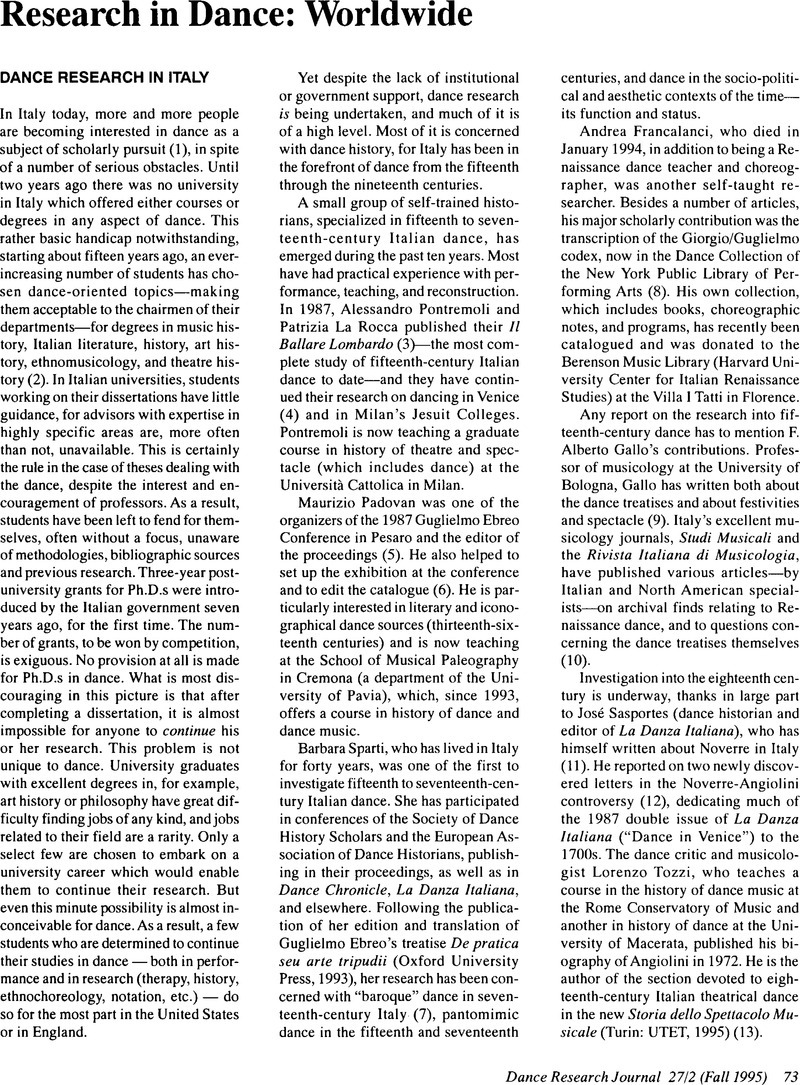No CrossRef data available.
Published online by Cambridge University Press: 22 July 2014

1. This report does not take into account the variety of books dealing with dance history, written by dance critics and journalists, and aimed at a more general public.
2. The “laurea” from an Italian university is more or less equivalent to a master's degree in the United States.
3. Milan: Vita e Pensiero.
4. La danza a Venezia nel Rinascimento (Vicenza: Neri Pozza Editore, 1993)Google Scholar.
5. Guglielmo Ebreo da Pesaro e la danza nelle corti italiane del XV secolo (Pisa: Pacini, 1990)Google Scholar.
6. Castelli, Patrizia, Mingardi, Maurizio and Padovan, Maurizio, eds. Mesura et arte del danzare… (Pesaro: Gualtieri, 1987)Google Scholar.
7. The quotation marks around “baroque” emphasize the ambiguity of the term and are intended to stress the total lack of similarity between the dance in seventeenth-century—“baroque”—Italy and the French noble style.
8. Basler Jahrbuch für historische Musikpraxis 14 (1990)Google Scholar.
9. Studi Musicali, nos. 8 (1979) and 12 (1983)Google Scholar; and in the Proceedings Spettacoli conviviali dall'antichità classica alle corti italiane del '400 (Rome: Nuova Coletti Editore, 1982)Google Scholar.
10. For example, McGee, Timothy and Jones's, Pamela articles, in English, in Studi Musicali 17 (1988)Google Scholar; 21 (1992). See also Nuova Rivista Musicale Italiana which has published articles on nineteenth- and twentieth-century dance by Lo Iacono and Veroli (see below).
11. La Danza Italiana 2 (1985)Google Scholar.
12. Ibid. 7 (1989).
13. See also his article on the ballets (in and out of operas) performed in Turin between 1748 and 1762, La Danza Italiana 2 (1985)Google Scholar.
14. See Sparti's, Barbara review in Dance Research Journal 26/1 (Spring 1994): 41–44CrossRefGoogle Scholar. As this report goes to press, we learn that, for financial and other editorial reasons, La Danza Italiana will no longer publish the AEHD proceedings.
15. Libreria Italiana Musicale, Lucca (hereafter cited as LIM). The next issue of La Danza Italiana is expected tin Spring 1996.
16. In 1986, for example, an issue was dedicated to Baroque dance in Rome and included important articles by both Elisabetta Mori (eighteenth century) and Alessandra Sardoni (seventeenth-century Jesuit Colleges).
17. See her article on Manzotti, and Marenco, (choreographer and composer of “Excelsior”) in Nuova Rivista Musicale Italiana 3 (1987)Google Scholar.
18. See, for example, her article, coauthored with Andrea Toschi, on the “gran ballo fantastico,” “Flik e Flok,” choreography by Paolo Taglioni, presented at the Scala, Milan, in 1862, in Chorégraphie 2 (1993)Google Scholar, and her chapter on “Il balletto in Italia nel 1800” in the forthcoming Storia dello spettacolo musicale.
19. See Giordano's, Gloria articles in Chorégraphie, and the BulletinGoogle Scholar, Danza e Società, edited by Fabio Mollica.
20. Bologna: Bora, 1991.
21. Milloss. Vita, arte e destino di un innovatore della danza, Lucca: LIMGoogle Scholar.
22. Her edition of Grazioso Cecchetti's manual of his father's method (Rome: Gremese, 1995), will be followed by an edition of Enrico Cecchetti's own un=published theoretical and technical works.
23. These are not really departments, but the Italian University system is far too complex to be explained in this article.
24. The future of the dance degree program is, however, precarious.
25. The recipient is Marina Nordera who, as part of her degree in History of Music, made a new translation into Italian of Lucian's, On the Dance (Venice: Marsilio, 1992)Google Scholar, analyzing its importance in the eighteenth century.
26. Her application for conference and travel expenses was filed December 30, 1994 and incorrectly processed by the CNR.
27. Past president was Donata Carbone who, together with Staro, taught Labanotation in Milan at the Civica Scuola d'Arte Drammatica ‘Paolo Grassi,’ which then had a research laboratory on traditional dance. Last year, for the first time, a seminar in “choreology” (practical and theoretical studies based on Laban's principles) was taught, by Laura Delfini, in the Department of Ethnomusicology (Folk Traditions) at Rome University.
28. Note, for example, A. William Smith's discovery in 1985 of a fifteenth-century Venetian description of dances; a fifteenth-century notary's jottings of ornamented dances found in the Viterbo Archives and studied by Barbara Sparti (1993-4); and the choreography in Feuillet notation of a dance by Gaetano Grossatesta (1725) reported by Giordano, Gloria in La Danza Italiana 1 (1989)Google Scholar.
29. Her book on theatrical dance in seventeenth-century Venetian opera will be published by University of Chicago Press.
30. Knud Arne Jurgensen has also used Italian archives, including the Verdi archive in Parma, for his research on dance in nineteenth-century Italian melodrama.
31. M.T. Gialdroni and G. Gialdroni, eds. (Lucca: LIM 1993).
32. See Toschi's, article in La Danza Italiana, 8–9 (1990)Google Scholar, and in Le Fonti Musicali in Italia 7 (1993)Google Scholar.
33. Published in collaboration with the Istituto Addestramento Lavoratori dello Spettacolo: Anita Bucchi, ed.; C. Lolacono, Dance Consultant.
34. Dance Research Journal 26/1 (Spring 1994): 44–46CrossRefGoogle Scholar.
35. Dance Research Journal 27/1 (Spring 1995): 51–52CrossRefGoogle Scholar.
36. Dance Research Journal 27/1 (Spring 1995): 56–59Google Scholar.